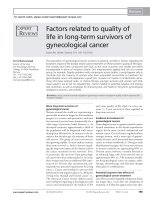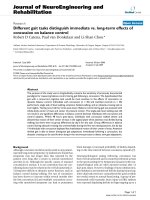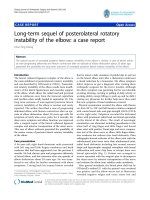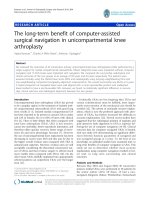Long term behavior of FRP strengthened RC beams
Bạn đang xem bản rút gọn của tài liệu. Xem và tải ngay bản đầy đủ của tài liệu tại đây (4.28 MB, 293 trang )
LONG-TERM BEHAVIOR OF
FRP-STRENGTHENED RC BEAMS
MITHUN KUMAR SAHA
NATIONAL UNIVERSITY OF SINGAPORE
2006
LONG-TERM BEHAVIOR OF
FRP-STRENGTHENED RC BEAMS
MITHUN KUMAR SAHA
B. Sc. Engg. (Civil), BUET
A THESIS SUBMITTED
FOR THE DEGREE OF DOCTOR OF PHILOSOPHY
DEPARTMENT OF CIVIL ENGINEERING
NATIONAL UNIVERSITY OF SINGAPORE
2006
i
Acknowledgements
ACKNOWLEDGEMENTS
First of all, the author would like to express his sincere gratitude to his supervisor,
Associate Professor Tan Kiang Hwee, for his precious guidance, immense patience,
constant encouragement and availability of comments whenever approached.
Many thanks are expressed to the staff of the Structural/Concrete laboratory for
their constructive suggestions and kind assistance in conducting the experimental
investigations. Grateful acknowledgement is extended to the National University of
Singapore for providing financial support to the author through the award of research
scholarship.
The author is deeply indebted to his parents for their vital sacrifices and perfect
guidance that brought the author to this successful stage of life. The author appreciates
all his friends for their constant inspiration throughout this study. Finally, the author
would like to dedicate any contribution of this work to his parents.
ii
TABLE OF CONTENTS
Title Page i
Acknowledgements ii
Table of Contents iii
Summary xi
List of Tables xiii
List of Figures xv
Nomenclature xx
CHAPTER 1 INTRODUCTION
1.1 General 1
1.2 Long-Term Effect on Structural Behavior of FRP-Strengthened RC Members 3
1.2.1 Effect of Sustained Loading 3
1.2.2 Effect of Cyclic Loading 4
1.2.3 Effect of Weathering 4
1.3 Objective and Scope of Study 6
iii
1.4 Research Significance 7
1.5 Thesis Structure 8
CHAPTER 2 LITERATURE REVIEW
2.1 Introduction 10
2.2 Long-Term Deflections 11
2.2.1 Effect of Concrete Creep and Shrinkage 11
2.2.2 Effect of Concrete Fatigue Damage 18
2.2.3 Effect of Weathering 21
2.3 Long-Term Crack Widths 22
2.3.1 Effect of Concrete Creep and Shrinkage 22
2.3.2 Effect of Concrete Fatigue Damage 24
2.3.3 Effect of Weathering 27
2.4 Residual Structural Behavior 28
2.5 Summary 31
Figures 34
CHAPTER 3 LONG-TERM BEHAVIOR OF FRP-STRENGTHENED RC
BEAMS UNDER SUSTAINED LOADING
3.1 General 37
3.2 Experimental Investigation 39
3.2.1 Test Program 39
3.2.2 Material Properties 40
3.2.2.1 Concrete Mix 40
iv
3.2.2.2 Steel Bars 41
3.2.2.3 Glass Fiber Reinforced Polymer System 41
3.2.3 Specimen Fabrication 42
3.2.4 Test Set-up and Instrumentation 43
3.3 Analytical Considerations 43
3.3.1 Calculation of Deflections 44
3.3.1.1 Short-Term Deflection 44
3.3.1.2 Time-Dependent Deflection 46
3.3.2 Estimation of Crack Widths 51
3.3.2.1 Short-Term Crack Width 51
3.3.2.2 Time-Dependent Crack Width 59
3.4 Test Results and Discussion 59
3.4.1 Deflection Characteristics 59
3.4.1.1 Effect of Sustained Loading 59
3.4.1.2 Effect of FRP Reinforcement Ratio 60
3.4.1.3 Comparison with Analytical Predictions 61
3.4.2 Cracking Behavior 63
3.4.2.1 Effect of Sustained Loading 63
3.4.2.2 Effect of FRP Reinforcement Ratio 64
3.4.2.3 Empirical Expressions for Time-Dependent Crack Width 65
3.5 Summary 66
Tables and Figures 68
v
CHAPTER 4 EFFECT OF CYCLIC LOADING ON LONG-TERM BEHAVIOR
OF FRP-STRENGTHENED RC BEAMS
4.1 General 94
4.2 Experimental Investigation 96
4.2.1 Test Program 96
4.2.2 Material Properties 97
4.2.3 Specimen Fabrication 98
4.2.4 Test Set-up and Instrumentation 99
4.3 Analytical Considerations 100
4.3.1 Factors Affecting Deflection and Crack Width under Cyclic Loading 100
4.3.1.1 Cyclic Creep of Concrete in Compression 100
4.3.1.2 Deterioration in Tensile Stiffening 102
4.3.1.3 Fatigue Damage of FRP Laminate in Tension 102
4.3.2 Calculation of Deflections 103
4.3.3 Estimation of Crack Widths 104
4.4 Test Results and Discussion 105
4.4.1 Deflection Characteristics 106
4.4.1.1 Effect of Load Range 106
4.4.1.2 Effect of FRP Reinforcement Ratio 107
4.4.1.3 Comparison with Analytical Predictions 108
4.4.2 Stiffness Degradation 109
4.4.2.1 Effect of Load Range 109
4.4.2.2 Effect of FRP Reinforcement Ratio 110
4.4.3 Strains in Concrete, Steel Bars and FRP Laminates 110
vi
4.4.4 Cracking Behavior 111
4.4.4.1 Effect of Load Range 111
4.4.4.2 Effect of FRP Reinforcement Ratio 111
4.4.4.3 Comparison with Analytical Predictions 112
4.4.5 Residual Structural Behavior 113
4.4.5.1 Static Flexural Strength 113
4.4.5.2 Failure Mode 115
4.4.5.3 Deflection and Stiffness 116
4.4.5.4 Ductility 118
4.4.5.5 Strains in Concrete, Steel Bars and FRP Laminates 118
4.4.5.6 Crack Width 120
4.5 Summary 121
Tables and Figures 123
CHAPTER 5 EFFECT OF WEATHERING ON LONG-TERM BEHAVIOR OF
FRP-STRENGTHENED RC BEAMS UNDER SUSTAINED
LOADING
5.1 General 143
5.2 Experimental Investigation 144
5.2.1 Test Program 145
5.2.1.1 Small Specimens 145
5.2.1.2 Large Specimens 146
5.2.2 Material Properties 147
5.2.2.1 Concrete Mix 147
vii
5.2.2.2 Steel Bars 147
5.2.2.3 FRP Laminate 148
5.2.3 Specimen Fabrication 149
5.2.3.1 Beam Description 149
5.2.3.2 Curing of Beams and FRP Installation 149
5.2.4 Simulation of Sustained Loading 150
5.2.4.1 Small Specimens 150
5.2.4.2 Large Specimens 151
5.2.5 Weathering Factors and Simulation 152
5.2.5.1 Weathering Factors 152
5.2.5.2 Simulation of Tropical Weathering 152
5.2.6 Instrumentation of Beams 156
5.2.6.1 Sustained Loading 156
5.2.6.2 Static Loading 156
5.3 Analytical Considerations 157
5.3.1 Prediction of Deflection 157
5.3.1.1 Factors Affecting Deflection 157
5.3.1.2 Calculation of Deflection 160
5.3.2 Estimation of Flexural Strength 162
5.3.2.1 Concrete Properties under Sustained Loading and Tropical
Weathering 164
5.3.2.2 Properties of FRP Laminate under Sustained Loading and
Tropical Weathering 164
5.3.2.3 Calculation of Flexural Strength 166
viii
5.4 Test Results and Discussion 168
5.4.1 Serviceability Limit State 168
5.4.1.1 Effect of Weathering 168
5.4.1.2 Effect of GFRP Type 169
5.4.1.3 Effect of FRP Reinforcement Ratio 170
5.4.1.4 Comparison of Observed Deflections
with Analytical Predictions 170
5.4.2 Ultimate Limit State 171
5.4.2.1 Flexural Strength 172
5.4.2.2 Ductility 174
5.4.2.3 Strains in Concrete, Steel Bars and FRP Laminates 175
5.4.2.4 Crack Widths and Failure Mode 175
5.4.2.5 Comparison of Test Results with Analytical Predictions 176
5.4.2.6 Comparison of Test Results with Beams Subjected to
Weathering Only 177
5.5 Summary 178
Tables and Figures 180
CHAPTER 6 CONCLUSIONS
6.1 Review of Work 213
6.2 Summary of Findings 215
6.2.1 Long-term Behavior of FRP-Strengthened RC Beams
under Sustained Loading 215
6.2.2 Effect of Cyclic Loading on Long-Term Behavior
of FRP-Strengthened RC Beams 216
ix
6.2.3 Effect of Weathering on Long-Term Behavior of FRP-Strengthened
RC Beams under Sustained Loading 217
6.3 Recommendations for Further Study 218
REFERENCES 220
APPENDIX A Preliminary Investigation on Steel Fiber Reinforced
Concrete (SFRC) Beams 230
APPENDIX B Stress-Strain Relations of Concrete, Steel Bars, and
Fiber Reinforced Polymer (FRP) Laminates 254
APPENDIX C Design Example on Deflection and Crack Width
of FRP-Strengthened RC Beam under Sustained Loading 256
APPENDIX D Design Example on Deflection and Crack Width
of FRP-Strengthened RC Beam under Cyclic Loading 260
APPENDIX E Design Example on Residual Flexural Strength
of GFRP-Strengthened RC Beam Subjected to
Sustained Loading under Tropical Weathering 264
x
Summary
Fiber Reinforced Polymer (FRP) system has gained popularity in the
strengthening of aged or deteriorated reinforced concrete (RC) members due to its high
strength to weight ratio and the ease of installation compared to other systems. However,
not much attention has been given to the long-term behavioral aspects of such
strengthened members. This research was aimed at investigating, both experimentally
and analytically, the long-term deflection, cracking and residual structural behavior of
RC beams strengthened with glass FRP system. The effect of three major actions, that is,
sustained loading, cyclic loading, and weathering were investigated.
Deflections and crack widths of RC beams under sustained or cyclic loading were
found to be effectively controlled by FRP laminates, besides the enhancement in flexural
strength. The beneficial effect was, however, less evident for beams subjected to
weathering for a long time. The flexural strength and ductility of FRP-strengthened RC
beams were found not much affected by cyclic loading. The same properties, however,
were found to reduce due to weathering with the failure mode changing from concrete
crushing to brittle FRP rupture.
The ACI approach, Effective Modulus Method and Adjusted Effective Modulus
Method were used to calculate the long-term deflection under sustained loading. The
first two approaches predicted the deflection conservatively, whereas the third one
showed excellent correlation with the test results. For beams subjected to sustained
loading under weathering, the Effective Modulus Method which considers the effect of
weathering on the modulus of beam components predicted the deflection on the
xi
conservative side. Also, an analytical approach was presented and found to predict the
deflection of FRP-strengthened RC beams under cyclic loading closely.
For the estimation of short-term crack width, a regression analysis of available
test data yields an empirical expression which is a function of stress in steel bars,
effective concrete area in tension, and effective side cover. The long-term crack width
due to sustained loading was related to the short-term crack width by empirical equations
which take into account the applied stress and the strengthening capacity of FRP laminate.
The long-term crack width due to cyclic loading was calculated following the classical
slip-theory approach taking into account the degradation in bond between steel bars and
concrete due to cyclic loading. The approach also considered the cyclic creep of concrete,
deterioration in tensile stiffening of concrete, and fatigue damage of FRP laminate and
was found to predict the test results closely.
Last, an analytical model which considers the combined effect of sustained
loading and weathering on individual material properties (that is, ultimate strain and
elastic modulus of concrete and FRP laminate) for different periods, is proposed to
determine the residual flexural strength of FRP-strengthened RC beams. This approach
involved setting a maximum strain limit for respective failure mode of concrete crushing,
FRP debonding and FRP rupture. The residual flexural strength and failure mode of
FRP-strengthened RC beams were predicted with reasonable accuracy. Subsequently, the
analytical prediction for residual strength is extrapolated to 50 years and a strength
reduction factor is proposed.
xii
List of Tables
Table 3.1 Test Program
Table 3.2 Properties of FRP Laminate and its Component used in Current Study
Table 3.3 Details of Test Beams
Table 3.4 Properties of FRP Systems used in Previous Studies
Table 3.5 Expressions for Short-Term Crack Width (in Imperial Units) in FRP-
Strengthened RC Beams
Table 3.6 Expressions for Short-Term Crack Width (in SI Units) in FRP-
Strengthened RC Beams
Table 3.7 Maximum Deflections of FRP-Strengthened RC Beams
Table 3.8 Maximum Crack Widths in FRP-Strengthened RC Beams
Table 4.1 Test Program
Table 4.2 FRP System and its Component Properties
Table 4.3 Static Test Results
Table 5.1(a) Test Program for Small Specimens (100 mm x 100 mm x 700 mm)
Table 5.1(b) Test Program for Large Specimens (100 mm x 125 mm x 2000 mm)
Table 5.2 Properties of FRP Systems
Table 5.3 Average Weathering Factors (1987-1997) (Liew 2003)
Table 5.4 Small RC Beams Strengthened with Type 1 (Unidirectional) GFRP
System
Table 5.5 Large RC Beams Strengthened with GFRP System
Table 5.6 Small RC Beams Strengthened with Type 2 (Bidirectional) GFRP System
xiii
Table 5.7 Crack Widths and Failure Mode
Table 5.8 Comparison of Observed Flexural Strength with Predictions
Table 5.9 Comparison of Observed Failure Mode with Predictions
Table 5.10(a) Effect of Sustained Loading in Weathered RC Beams Strengthened with
Type 1 (Unidirectional) GFRP System
Table 5.10(b) Effect of Sustained Loading in Weathered RC Beams Strengthened with
Type 2 (Bidirectional) GFRP System
Table A.1 Beam Designation
Table A.2 Flexural Test Results
Table C.1 FRP Laminate Properties Reported by Manufacturer
Table C.2 Properties of Steel Bars
xiv
List of Figures
Fig. 2.1 Cycle-Dependent Secant Modulus of Elasticity (Balaguru and Shah 1982)
Fig. 2.2 Comparison of Calculated Deflections with Measured Values (Lovegrove
and El Din 1987)
Fig. 2.3 Increase in Average Measured Steel Strains with Repeated Loads (Breña
et al. 2005)
Fig. 2.4 Crack Width vs. Number of Cycles (Toutanji et al. 2003)
Fig. 2.5 Effect of Number of Weathering Cycles on Ultimate Beam Strength
(Chajes et al. 1995)
Fig. 2.6 Load-Deflection Response of Beams kept in Weathering Chamber for
Various Exposure Period (Liew 2003)
Fig. 3.1 Test Beam and Section Details
Fig. 3.2 Test Set-up
Fig. 3.3 Concrete Section Before and After Cracking
Fig. 3.4 Comparison of ACI (ACI 224R 2004) and CEB-FIP Model Code (1990)
Approaches for Short-Term Crack Width in Conventional RC Beams
Fig. 3.5 Specimen Details
Fig. 3.6 Verification of Currently Available Approaches for Short-Term Crack
Width in FRP-Strengthened RC Beams
Fig. 3.7 Comparison between Observed and Calculated Crack Widths (in Imperial
Units)
Fig. 3.8 Comparison between Observed and Calculated Crack Widths (in SI Units)
Fig. 3.9 Definition of Effective Side Cover
Fig. 3.10 Deflections of Beams under Different Sustained Load Levels
Fig. 3.11 Deflections of Beams with Different FRP Reinforcement Ratios
xv
Fig. 3.12 Deflections of Beams with Equal Sustained Load Ratio
Fig. 3.13 Comparison of Test Results with Predictions of ACI Approach (ACI
Committee 224R 2004)
Fig. 3.14 Comparison of Long-Term Deflection Multipliers
Fig. 3.15 Comparison of Test Results with Predictions of Effective Modulus
Method (EMM)
Fig. 3.16 Comparison of Test Results with Predictions of Adjusted Effective
Modulus Method (AEMM)
Fig. 3.17 Crack Widths of Beams under Different Sustained Load Levels
Fig. 3.18 Crack Widths of Beams with Different FRP Reinforcement Ratios
Fig. 3.19 Crack Widths of Beams with Equal Sustained Load Ratio
Fig. 3.20 Time-Dependent/Instantaneous Crack Width
Fig. 3.21 Empirical Models for Long-Term Crack Width
Fig. 4.1 Beam Details and Test Set-up
Fig. 4.2 Test Instrumentation
Fig. 4.3 Mid-Span Deflections
Fig. 4.4 Comparison of Test Results (Deflections) with Analytical Predictions
Fig. 4.5 Effect of Load Range on Stiffness Degradation
Fig. 4.6 Effect of FRP Reinforcement Ratio on Stiffness Degradation
Fig. 4.7 Normalized Stiffness
Fig. 4.8 Concrete Strains under Cyclic Loading at Mid-Span Sections
Fig. 4.9 Steel Strains under Cyclic Loading at Mid-Span Sections
Fig. 4.10 FRP Strains under Cyclic Loading at Mid-Span Sections
Fig. 4.11 Maximum Crack Widths under Cyclic Loading
xvi
Fig. 4.12 Comparison of Test Results (Crack Widths) with Analytical Predictions
Fig. 4.13 Load-Deflection Curves under Static Loading
Fig. 4.14 Concrete Strains under Static Loading at Mid-Span Sections
Fig. 4.15 Steel Strains under Static Loading at Mid-Span Sections
Fig. 4.16 FRP Strains under Static Loading at Mid-Span Sections
Fig. 4.17 Maximum Crack Widths under Static Loading
Fig. 5.1 Test Beams and Section Details
Fig. 5.2 Determination of Sustained Loading to Simulate Accelerated Behavior
Fig. 5.3 Schematic Drawing of Beams Subjected to Sustained Loading
Fig. 5.4 Beams Subjected to Sustained Loading inside Weathering Chamber
Fig. 5.5 Weathering Chambers
Fig. 5.6 Simulation of Tropical Weathering inside Weathering Chamber
Fig. 5.7 Beams under Static Loading
Fig. 5.8 Schematic Creep Behavior of FRP Laminate (Holmes and Just 1983)
Fig. 5.9 Effect of Weathering on Long-Term Serviceability
Fig. 5.10 Effect of GFRP Type on Long-Term Serviceability
Fig. 5.11 Effect of FRP Reinforcement Ratio on Long-Term Deflection
Fig. 5.12 Comparison of Observed Deflections with Analytical Predictions
Fig. 5.13 Degradation in Flexural Strength
Fig. 5.14 Load-Deflection Behavior of Small RC Beams Strengthened with Type 1
(Unidirectional) GFRP System
Fig. 5.15 Static Behavior of Large RC Beams Strengthened with GFRP Laminates
xvii
Fig. 5.16 Load-Deflection Behavior of Small RC Beams Strengthened with Type 2
(Bidirectional) GFRP System
Fig. 5.17 Degradation in Ductility
Fig. 5.18 Strains at Mid-Span Sections in Small RC Beams Strengthened with Type
1 (Unidirectional) GFRP System
Fig. 5.19 Strains at Mid-Span Sections in Small RC Beams Strengthened with Type
2 (Bidirectional) GFRP System
Fig. 5.20 Strains at Mid-Span Sections in Large RC Beams Strengthened with
GFRP Laminates
Fig. 5.21 Prediction of Degradation in Flexural Strength
Fig. 5.22 Effect of Sustained Loading on Residual Strength and Ductility of
Weathered Beams
Fig. A.1 Beam Cross-Section Properties and Sustained Loading Test Set-up
Fig. A.2 SFRC Beams (P
s
/P
u
= 0.5) with Various Fiber Contents
Fig. A.3 SFRC Beams (V
f
= 1%) under Different Sustained Load Levels
Fig. A.4 Comparison of Test Results with Predictions of Modified ACI Approach
Fig. A.5 Comparison of Test Results with Predictions of Effective Modulus
Method
Fig. A.6 Comparison of Test Results with Predictions of Adjusted Effective
Modulus Method
Fig. A.7 Maximum Crack Widths for Beams with Various Fiber Contents and
Sustained Load Levels
Fig. A.8 Regression Analysis and Comparison with Test Results for Long-Term
Crack Widths
Fig. A.9 Comparison of Load-Deflection Characteristics between Original and
Aged Beams (Series I)
Fig. A.10 Comparison of Load-Maximum Crack Width Relations between Original
and Aged Beams (Series I)
xviii
Fig. A.11 Deflection and Cracking Behavior of Series II Beams when Tested to
Failure
Fig. B.1 Idealized Stress-Strain Relations for Concrete, Steel Bar and FRP
Laminate
Fig. C.1 Schematic Drawing of an Idealized FRP-Strengthened RC Beam
xix
Nomenclature
a = shear span
A = area of concrete symmetric with tensile steel bars, divided by the
number of bars
A
c
= gross concrete area
A
ce
= effective concrete area in tension
A
frp
= area of FRP laminate
/
,
ss
AA
= areas of tensile and compressive steel bars, respectively
b = width of beam section
b
frp
= width of FRP laminate
c
1
= initial maximum crack spacing
c
2
, = maximum crack spacing after N cycles of loading
c
C
= compression force in concrete
s
C
= compression force in steel bars
/
, dd
= distances from compression-most face to the centroids of tensile
and compressive steel bars, respectively
d
b
= diameter of steel bar
e
= eccentricity of fictitious compression force from centroid of
section
c
E
= elastic modulus of concrete
e
E
= effective elastic modulus of concrete
//
e
E
= age-adjusted effective elastic modulus of concrete
E
e,N
= effective cycle-dependent modulus of concrete
xx
f
E
= elastic modulus of fiber reinforcement
E
frp
= elastic modulus of FRP laminate
E
frp,N
= elastic modulus of FRP laminate after N cycles of loading
E
frp,t
= elastic modulus of FRP laminate at time t under sustained loading
E
frp,w
= elastic modulus of FRP laminate due to sole effect of weathering
E
frp,wt
= elastic modulus of FRP laminate under combined sustained loading
and weathering
EI
0
= initial beam stiffness
EI
n
= beam stiffness after N cycles of loading
m
E
= elastic modulus of resin
s
E
= elastic modulus of steel bars
f
i
, f
t
= initial stress and time-dependent stress in concrete, respectively
/
c
f
= concrete cylinder compressive strength
cr
f
= initial modulus of rupture of concrete
f
cr,N
= modulus of rupture of concrete after N cycles of loading
f
ctm
= mean tensile strength of concrete
f
cu
= concrete cube compressive strength
f
frp
= initial stress in FRP laminate
f
frp,N
= stress in FRP laminate after N cycles of loading
f
frp,u
= ultimate tensile strength of FRP laminate
f
frpu,wt
= ultimate tensile strength of FRP laminate under combined
sustained loading and weathering
f
m
,
m
f
= static mean stress and normalized mean stress, respectively
xxi
f
max
, f
min
= maximum and minimum applied stress on concrete, respectively,
during cyclic loading
f
s
= stress in steel bars
f
y
, f
y
/
= yield strength of tensile and compressive steel bars, respectively
Δ
f,
fΔ
= stress range and normalized stress range, respectively
h
= depth of beam section
h
1
= distance from neutral axis to centroid of tensile steel bars
I
= moment of inertia of age-adjusted transformed section
I
c
= moment of inertia of concrete section
Ncrtcrcr
III
,,
,,
= moment of inertia of a cracked section at the start of loading,
at time t, and after N cycles of loading, respectively
I
cr,wt
= moment of inertia of a cracked beam section under combined
sustained loading and weathering
Netee
III
,,
,,
= effective moment of inertia of beam section at the start of loading,
at time t, and after N cycles of loading, respectively
I
e,wt
= effective moment of inertia of beam section under combined
sustained loading and weathering
tg
II ,
= moment of inertia of gross and transformed sections, respectively
l = beam clear span
l
s,max
= length over which slip occurs between concrete and steel bars
L = bond length of FRP laminate
L
e
= effective bond length of FRP laminate
a
M
= applied maximum moment
M
cc
, M
fr
, M
db
= moment capacity of a beam section corresponding to concrete
crushing, FRP rupture and FRP debonding, respectively
xxii
cr
M
= initial cracking moment
M
cr,N
= cracking moment of beam subjected to N cycles of loading
res
M
= resisting moment
M
u
= ultimate moment capacity of a beam section
ΔM = change in moment with time
t
nn,
= modular ratio of steel bars to concrete at the start of loading, and at
time
t, respectively
tfrpfrp
nn
,
,
= modular ratio of FRP laminate to concrete at the start of loading,
and at time t, respectively
n
frp,wt
= modular ratio of FRP laminate to concrete at time t, under
combined sustained loading and weathering
N = number of cycles
∑O = sum of perimeter of steel bars
P = total applied load on beam
P
0
, P
1
, P
2
, P
3
= ultimate load capacity of RC beam strengthened with FRP
laminate of 0, 1, 2 and 3 layers, respectively
P
max
, P
min
= maximum and minimum load during cyclic loading, respectively
P
s
, P
u
= sustained load and ultimate load of a beam, respectively
ΔP = difference between maximum and minimum applied load
t, t
0
= time at which deflection is to be computed, and age of
concrete at the time of application of load, respectively
/
t = time at the onset of drying in days
t
b
= bottom cover to the center of nearest steel bar
t
c
, t
e
= elapsed time in chamber and in outdoor (exterior) condition,
respectively
t
frp
= thickness of FRP laminate
xxiii
t
r
= distance from extreme tensile fiber to resultant tensile force
t
s
= side cover to the center of nearest steel bar
t
se
= effective concrete cover
T = fictitious compression force in steel and FRP laminate
s
T
= tension force in tensile steel bars
frp
T
= tension force in FRP laminate
U = bond strength of steel bars
f
V
= volume fraction of fiber reinforcement
m
V
= volume fraction of resin
w
= uniformly distributed load
w
i
,
w
total
= instantaneous and total crack width, respectively
w
N
, w
t
= crack width after N cycles of loading and at time t, respectively
x, x
t
, x
N
= neutral axis depth of a cracked beam section at time of application
of loading, at time t, and after N cycles of loading, respectively
x
= neutral axis depth of an uncracked beam section
x
c
= distance of resultant compression force in concrete from extreme
compressive fiber
x
wt
= neutral axis depth of beam section under combined sustained
loading and weathering
y
c
= distance between centroid of compressive concrete area from the
centroid of age-adjusted transformed section
α
= experimental coefficient for time-dependent curvature
l
β
= bond length coefficient
w
β
= bond width coefficient
xxiv









